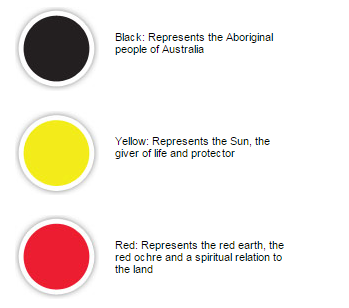The Golden Sun: Unveiling the Meaning of Yellow in the Aboriginal Flag
The Golden Sun: Unveiling the Meaning of Yellow in the Aboriginal Flag

The Aboriginal flag, a powerful symbol of Indigenous Australian identity, is a vibrant tapestry of black, red, and yellow. Each color carries deep meaning, reflecting the rich history, culture, and aspirations of the First Australians. While the black represents the Aboriginal people, and the red symbolizes the earth and their connection to the land, the yellow holds a special significance, representing the sun and its life-giving power.
This article delves into the profound symbolism of the yellow in the Aboriginal flag, exploring its connection to the sun, the land, and the enduring spirit of Indigenous Australians.
Related Articles: The Golden Sun: Unveiling the Meaning of Yellow in the Aboriginal Flag
- Unpacking The Nuances: Understanding Aboriginal And Indigenous
- Breaking Barriers: The Rise Of Indigenous Women In Film And Television
- A Taste Of The Outback: Exploring The Vibrant World Of Australian Fruits
- The Ancient Custodians Of The Land: A Glimpse Into The Rich History And Culture Of Australian Aboriginal Peoples
- Unraveling The Tapestry Of Meaning: Exploring The Symbolism And Art Of Indigenous Australians
The Sun: A Source of Life and Strength
The sun, a celestial body revered by many cultures worldwide, holds a central position in Aboriginal beliefs and practices. In the vast expanse of the Australian outback, the sun is a constant presence, its warmth and light sustaining life. It marks the passage of time, dictates the seasons, and provides a vital source of energy.
The yellow in the Aboriginal flag symbolizes the sun, recognizing its fundamental role in the lives of Indigenous Australians. It represents not only the physical sun but also its metaphorical meaning as a source of strength, resilience, and hope. Just as the sun rises each day, bringing light to the world, the yellow color embodies the enduring spirit of Aboriginal people, their ability to overcome adversity and continue their journey through life.
The Sun’s Connection to the Land
The sun’s influence extends beyond its physical presence. It plays a crucial role in the cycle of life, nurturing the land and its diverse ecosystems. From the growth of native plants to the survival of animals, the sun’s energy sustains the delicate balance of the Australian environment.
The yellow in the flag, therefore, represents the land, the connection between Aboriginal people and their ancestral territories. It signifies the vibrant tapestry of life that flourishes under the sun’s rays, from the red earth to the blue sky above. The land is not merely a physical space but a living entity, imbued with spiritual significance and ancestral knowledge passed down through generations.
The Sun as a Symbol of Hope and Renewal
Beyond its physical and spiritual significance, the sun also holds a powerful metaphorical meaning for Aboriginal people. It represents hope, renewal, and the promise of a brighter future. Just as the sun rises each day, bringing new light and possibilities, the yellow color symbolizes the enduring spirit of Indigenous Australians, their resilience in the face of challenges, and their unwavering belief in a better tomorrow.

The Aboriginal flag, with its vibrant yellow, serves as a reminder of the strength and resilience of Indigenous Australians, their deep connection to the land, and their unwavering hope for a future where their culture, traditions, and voices are honored and celebrated.
The Yellow: A Symbol of Unity and Identity
The yellow in the Aboriginal flag also represents unity and shared identity. It binds together the diverse Aboriginal communities across Australia, signifying their shared history, culture, and aspirations.
The sun, a universal symbol of life and light, transcends the boundaries of individual tribes and nations, uniting all Aboriginal people under its radiant glow. It embodies their shared heritage, their collective strength, and their unwavering determination to preserve their traditions and culture for generations to come.
The Yellow: A Call to Action

The yellow in the Aboriginal flag is not merely a symbol of the past, but a call to action for the future. It represents the ongoing struggle for recognition, justice, and reconciliation. It urges Australians to acknowledge the history of Indigenous people, to understand their unique perspectives, and to work towards a future where all Australians can live together in harmony and respect.
The Yellow: A Source of Inspiration
The yellow in the Aboriginal flag is a powerful symbol of inspiration, reminding us of the resilience, strength, and cultural richness of Indigenous Australians. It challenges us to learn from their wisdom, to embrace their traditions, and to work towards a future where all Australians can live together in a spirit of respect and understanding.
The Yellow: A Legacy for Future Generations
The yellow in the Aboriginal flag is a legacy for future generations, a reminder of the enduring spirit of Indigenous Australians and their connection to the land. It represents a hope for a future where their culture, traditions, and voices are celebrated and honored, and where their stories are shared with the world.

FAQ about the Yellow in the Aboriginal Flag:
Q: What does the yellow in the Aboriginal flag represent?
A: The yellow in the Aboriginal flag represents the sun, its life-giving power, and the enduring spirit of Indigenous Australians. It also symbolizes the land, the connection between Aboriginal people and their ancestral territories, and their unity and shared identity.
Q: Why is the sun so important to Aboriginal people?
A: The sun is a vital source of life for Aboriginal people, providing warmth, light, and energy. It plays a crucial role in the cycle of life, nurturing the land and its diverse ecosystems. The sun also holds a powerful metaphorical meaning, representing hope, renewal, and the promise of a brighter future.
Q: What is the significance of the yellow color in Aboriginal culture?
A: The color yellow holds a special significance in Aboriginal culture, representing the sun, the land, and the enduring spirit of Indigenous Australians. It is often associated with warmth, light, hope, and resilience.
Q: How does the yellow in the flag connect to the land?
A: The yellow in the flag symbolizes the land, the connection between Aboriginal people and their ancestral territories. It represents the vibrant tapestry of life that flourishes under the sun’s rays, from the red earth to the blue sky above.
Q: What message does the yellow in the flag convey to non-Indigenous Australians?
A: The yellow in the flag serves as a reminder of the strength and resilience of Indigenous Australians, their deep connection to the land, and their unwavering hope for a future where their culture, traditions, and voices are honored and celebrated. It is a call to action for non-Indigenous Australians to acknowledge the history of Indigenous people, to understand their unique perspectives, and to work towards a future where all Australians can live together in harmony and respect.
Q: How can I learn more about the Aboriginal flag and its symbolism?
A: There are many resources available to learn more about the Aboriginal flag and its symbolism, including websites, books, and documentaries. You can also visit local museums and galleries that feature exhibits on Indigenous Australian culture and history.
The yellow in the Aboriginal flag is a powerful symbol of the enduring spirit of Indigenous Australians, their deep connection to the land, and their unwavering hope for a brighter future. It is a reminder of the importance of recognizing and celebrating the rich culture and history of the First Australians, and of working towards a future where all Australians can live together in harmony and respect.

Closure
Thus, we hope this article has provided valuable insights into The Golden Sun: Unveiling the Meaning of Yellow in the Aboriginal Flag. We appreciate your attention to our article. See you in our next article!